

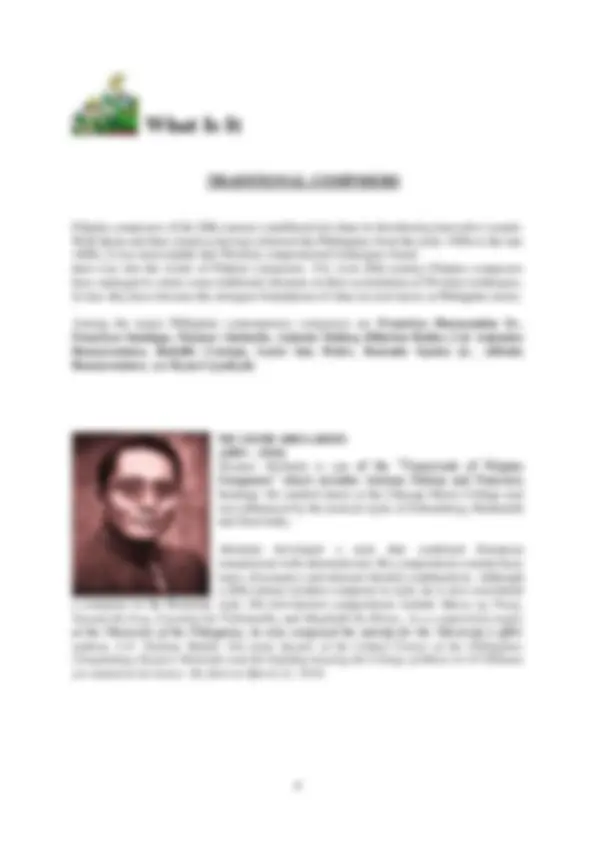
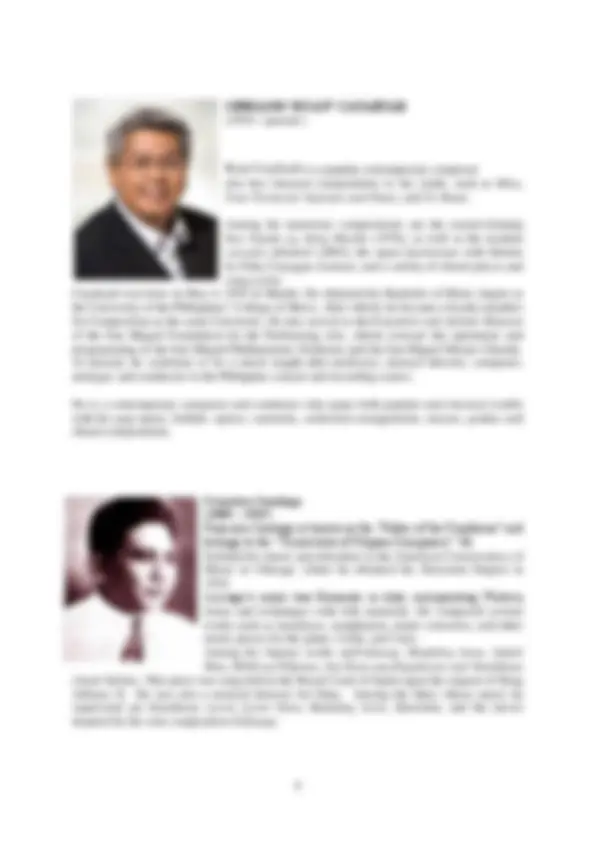
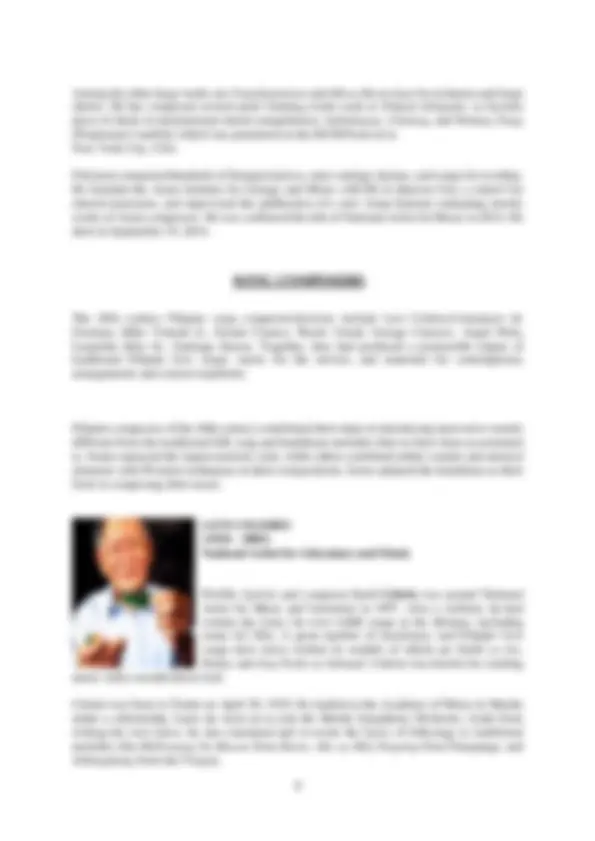
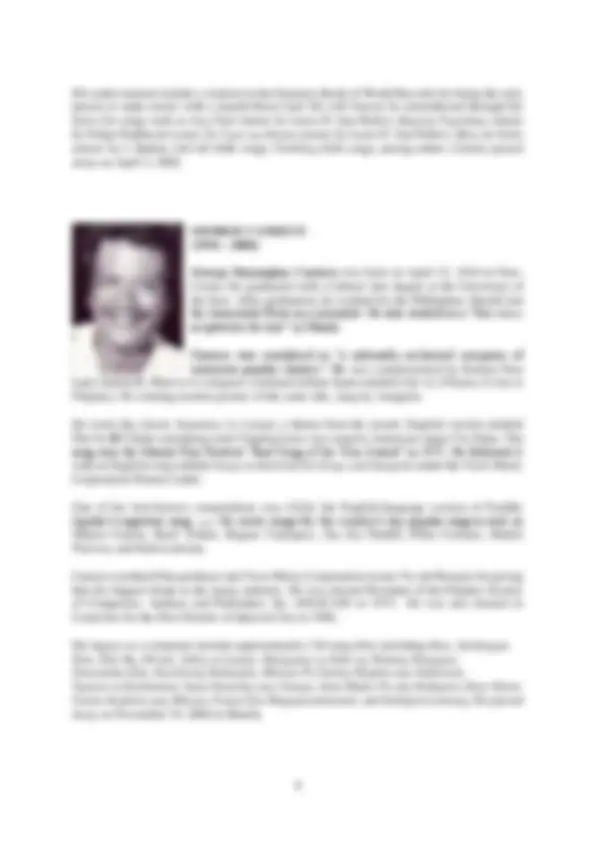
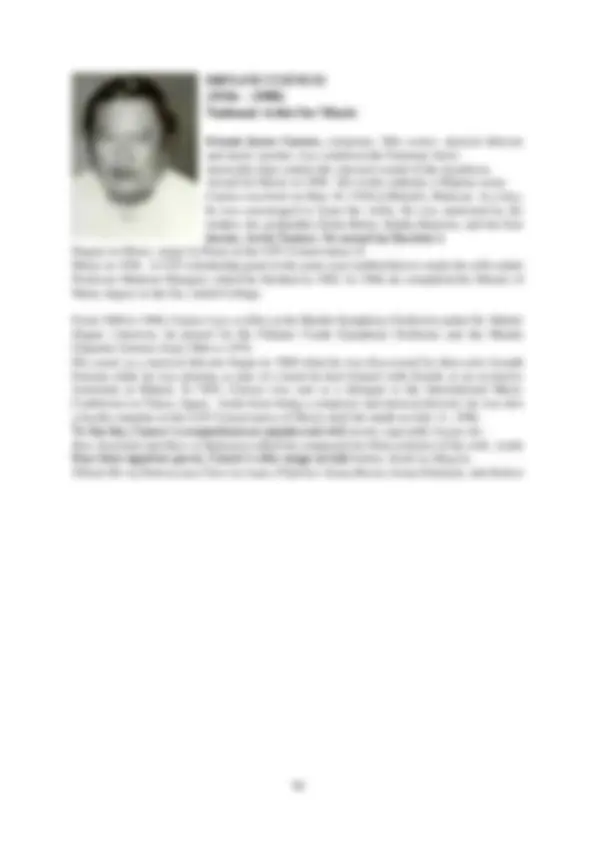


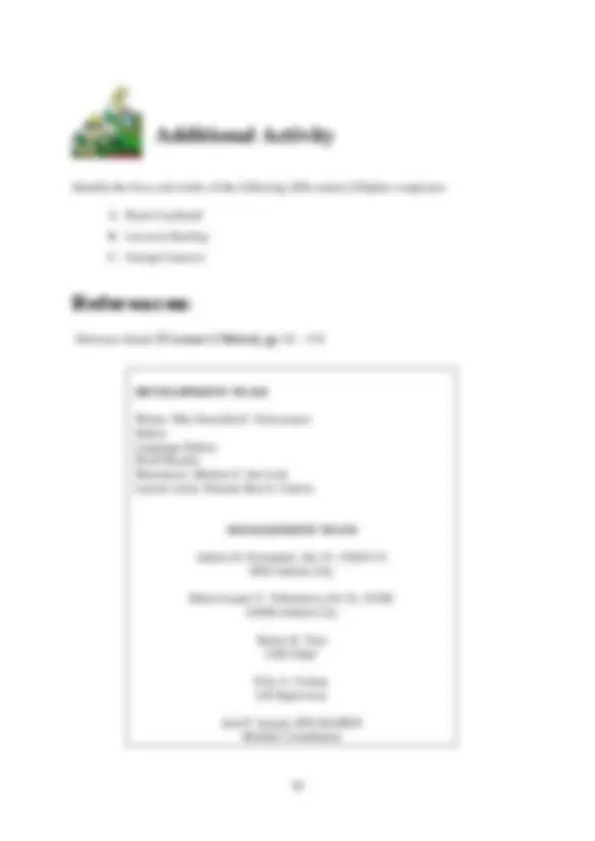


Study with the several resources on Docsity

Earn points by helping other students or get them with a premium plan


Prepare for your exams
Study with the several resources on Docsity

Earn points to download
Earn points by helping other students or get them with a premium plan
Community
Ask the community for help and clear up your study doubts
Discover the best universities in your country according to Docsity users
Free resources
Download our free guides on studying techniques, anxiety management strategies, and thesis advice from Docsity tutors
MUSIC. Quarter 3 – Module 1: CONTEMPORARY PHILIPPINE MUSIC ... Narrates the life of selected contemporary Filipino composer/s (MU10CM-IIIc-g-3).
Typology: Assignments
1 / 17

This page cannot be seen from the preview
Don't miss anything!











On special offer
1
Department of Education
Quarter 3 – Module 1: CONTEMPORARY PHILIPPINE MUSIC (TRADITIONAL, NEW MUSIC AND SONG COMPOSERS) Z est for P rogress Z eal of P artnership
Name of Learner: ___________________________ Grade & Section: ___________________________ Name of School: ___________________________
At the end of the module, each student is expected to:
According to National Artist Ramon Santos, PhD, “contemporary music in the Philippines refers to compositions that have adopted ideas and elements from 20th century art music in the west, as well as the latest trends and musical styles in the entertainment industry.” The modern Filipino repertoire consists of musical pieces that have been written in 20th century idioms that have evolved out of such stylistic movements as impressionism, expressionism, neo-classicism, as well as avant-garde and new music. New music are compositions which are improvisational works such as the early compositions of Dr. Ramon Santos , Radyasyon and Quadrasyon ; Josefino “Chino” Toledo’s Samut-Sari, Pintigan and Terminal Lamentations, and Jonathan Baes’ Wala and Banwa. With the European and American influences brought by our country’s colonizers, it ws inevitable that the musical style of 20th^ century Western composers found their way into Philippine compositions. The works many notable Filipino composers are evidence of this. An entire group of 20th^ Filipino song composers became popular for their musical compositions used as background music or theme songs in movies and films. What I Need To Know KKKKKNOWKNOW
Filipino composers of the 20th century contributed teir share in introducing innovative sounds. With Spain and then America having colonized the Philippines from the early 1500s to the late 1800s, it was unavoidable that Western compositional techniques found their way into the works of Filipino composers. Yet, even 20th century Filipino composers have managed to retain some traditional elements in their assimilation of Western techniques. In fact, they have become the strongest foundations of what we now know as Philippine music. Among the major Philippine contemporary composers are Francisco Buencamino Sr. , Francisco Santiago, Nicanor Abelardo, Antonio Molina, Hilarion Rubio, Col. Antonino Buenaventura, Rodolfo Cornejo, Lucio San Pedro , Rosendo Santos Jr. , Alfredo Buenaventura , and Ryan Cayabyab. NICANOR ABELARDO (1893 – 1934) Nicanor Abelardo is one of the “Triumvirate of Filipino Composers” which includes Antonio Molina and Francisco Santiago. He studied music at the Chicago Music College and was influenced by the musical styles of Schoenberg, Hindemith and Stravinsky. Abelardo developed a style that combined European romanticism with chromaticism. His compositions contain hazy tones, dissonance and unusual chordal combinations. Although a 20th century modern composer in style, he is also considered a composer in the Romantic style. His best-known compositions include Mutya ng Pasig, Nasaan Ka Irog, Cavatina for Violoncello, and Magbalik Ka Hiran.. As a composition major at the University of the Philippines, he also composed the melody for the University’s offcil anthem, U.P. Naming Mahal. The main theater of the Culturl Center of the Philippines (Tanghalang Nicanor Abelardo) and the building housing the College of Music in UP Diliman are named in his honor. He died on March 21, 1934. What Is It
(1954 – present ) Ryan Cayabyab (^) is a popular contemporary composer also has classical compositions to his credit, such as Misa , Four Poems for Soprano and Piano , and Te Deum. Among his numerous compositions are the award-winning Kay Ganda ng Ating Musika (1978), as well as the modern zarzuela Alikabok (2003), the opera Spoliarium with libretto by Fides Cuyugan-Asensio, and a variety of choral pieces and song cycles. Cayabyab was born on May 4, 1954 in Manila. He obtained his Bachelor of Music degree at the University of the Philippines’ College of Music. After which, he became a faculty member for Composition at the same University. He also served as the Executive and Artistic Director of the San Miguel Foundation for the Performing Arts, which oversaw the operations and programming of the San Miguel Philharmonic Orchestra and the San Miguel Master Chorale. At present, he continues to be a much sought-after professor, musical director, composer, arranger, and conductor in the Philippine concert and recording scenes. He is a contemporary composer and conductor who spans both popular and classical worlds with his pop music, ballads, operas, zarzuelas, orchestral arrangements, masses, psalms and choral compositions. Francisco Santiago (1889 – 1947) Francisco Santiago is known as the “Father of the Kundiman” and belongs to the “Triumvirate of Filipino Composers.” He finished his music specialization at the American Conservatory of Music in Chicago, where he obtained his Doctorate Degree in
Santiago’s music was Romantic in style, incorporating Western forms and techniques with folk materials. He composed several works such as kundiman , symphonies, piano concertos, and other music pieces for the piano, violin, and voice. Among his famous works are Pakiusap, Madaling Araw, Sakali Man, Hibik ng Pilipinas, Ano Kaya ang Kapalaran, and Kundiman (Anak Dalita). This piece was sung before the Royal Court of Spain upon the request of King Alfonso II. He was also a musical director for films. Among the films whose music he supervised are Kundiman, Leron Leron Sinta, Madaling Araw, Manileña, and the movie inspired by his own composition Pakiusap.
National Artist for Music Ramon P. Santos was born in Pasig on February 25, 1941. He completed his Bachelor of Music degree at the College of Music, University of the Philippines. He finished his Master of Music degree at Indiana University, USA. He received his Doctor of Philosophy degree in Composition at the State University of New York, USA. He had also pursued graduate studies in Ethnomusicology at the University of Illinois, USA. Santos’ compositional style features chromaticism, musicseria and electronic components, combined with indigenous Philippine music elements. His works include Ding Ding Nga Diyawa , Nabasag na Banga at Iba’t iba pang Pinag-ugpong-ugpong na Pananalita sa Wikang Pilipino para sa Labing Anim na Tinig , and L’BAD. He had done extensive research on the gamelan music of Java as well as the traditional music of the Ibaloi, Maranao, Mansaka, Bontoc, Yakan, and Boholano tribes in the Philippines. present, he is the headof the UP Center of Ethnomusicologyand was appointed Professor. Santos held the position of Dean of the UP College of Music from 1978 to 1988. At Emeritus of the same institution. He was conferred the title of National Artist for Music in
FRANCISCO F. FELICIANO (1942 – 2014) National Artist for Music Francisco F. Feliciano, avant garde composer and conductor for band and chorus, was born on February 19, 1942 in Morong, Rizal. His first exposure to music was with the Morriz Band, a brass ensemble established and owned by his father, Maximiano Feliciano. He started his music career in the high school band where he had played the cymbals and the clarinet. Feliciano obtained his Teacher’s Diploma in Composition and Conducting at the Conservatory of Music, University of the Philippines (UP) in 1964, and a Bachelor of Music degree major in Composition in 1967. Subsequent degrees include a Master in Music Composition from the University of the Philippines, a Diploma in Music Composition from the Hochschule der Kunst in Berlin, Germany, and a Master of Musical Arts and Doctorate in Music Composition from Yale University School of Music, USA. He studied composition with Jacob Druckman, Isang Yun, H.W. Zimmerman and Krystof Penderecki. Feliciano composed more than 30 major works, including the musical dramas Sikhay sa Kabila ng Paalam, Ashen Wings, and the monumental three-act opera La Loba Negra (1984). He also wrote music for the orchestra such as Prelude and Toccata (1973), Fragments (1976), Life of Wartime Filipino Hero Jose Abad Santos, and the ballet Yerma (1982).
Among his other large works are Transfiguration and Missa Mysterium for orchestra and large chorus. He has composed several prize winning works such as Pokpok Alimpako, (a favorite piece of choirs in international choral competitions), Salimbayan, Umiinog, and Walang Tinag (Perpetuum I mobile) which was premiered at the ISCM Festival in New York City, USA. Feliciano composed hundreds of liturgical pieces, mass settings, hymns, and songs for worship. He founded the Asian Institute for Liturgy and Music (AILM) in Quezon City, a school for church musicians, and supervised the publication of a new Asian hymnal containing mostly works of Asian composers. He was conferred the title of National Artist for Music in 2014. He died on September 19, 2014.
The 20th century Filipino song composers/lyricists include Levi Celerio,Constancio de Guzman, Mike Velarde Jr., Ernani Cuenco, Restie Umali, George Canseco, Angel Peña, Leopoldo Silos Sr., Santiago Suarez. Together, they had produced a memorable output of traditional Filipino love songs, music for the movies, and materials for contemporary arrangements and concert repertoire. Filipino composers of the 20th century contributed their share in introducing innovative sounds different from the traditional folk song and kundiman melodies that we have been accustomed to. Some espoused the impressionistic style, while others combined ethnic sounds and musical elements with Western technqiues in their compositions. Some adopted the kundiman as their form in composing their music. LEVI CELERIO (1910 – 2002) National Artist for Literature and Music Prolific lyricist and composer Levi Celerio was named National Artist for Music and Literature in 1997. Also a violinist, he had written the lyrics for over 4,000 songs in his lifetime, including many for film. A great number of kundimans and Filipino love songs have lyrics written by notable of which are Dahil sa Iyo, Buhat, and Ang Pasko ay Sumapit. Celerio was known for creating music with a mouth-blown leaf. Celerio was born in Tondo on April 30, 1910. He studied at the Academy of Music in Manila under a scholarship. Later, he went on to join the Manila Symphony Orchestra. Aside from writing his own lyrics, he also translated and re-wrote the lyrics of folksongs to traditional melodies like Maliwanag Na Buwan from Ilocos, Ako ay May Singsing from Pampanga, and Alibangbang from the Visayas.
Ernani Joson Cuenco, composer, film scorer, musical director and music teacher, was conferred the National Artist musicality that contain the classical sound of the kundiman. Award for Music in 1999. His works embody a Filipino sense Cuenco was born on May 10, 1936 in Malolos, Bulacan. As a boy, he was encouraged to learn the violin. He was mentored by his mother, his godmother Doña Belen Aldaba Bautista, and his first teacher, Jovita Tantoco. He earned his Bachelor’s Degree in Music, major in Piano at the UST Conservatory of Music in 1956. A UST scholarship grant in the same year enabled him to study the cello under Professor Modesto Marquiz, which he finished in 1965. In 1968, he completed his Master of Music degree at the Sta. Isabel College. From 1960 to 1968, Cuenco was a cellist at the Manila Symphony Orchestra under Dr. Hubert Zipper. Likewise, he played for the Filipino Youth Symphony Orchestra and the Manila Chamber Soloists from 1966 to 1970. His career as a musical director began in 1960 when he was discovered by then actor Joseph Estrada while he was playing as part of a band he had formed with friends at an exclusive restaurant in Makati. In 1963, Cuenco was sent as a delegate to the International Music Conference in Tokyo, Japan. Aside from being a composer and musical director, he was also a faculty member at the UST Conservatory of Music until his death on July 11, 1988. To this day, Cuneco’s compositions are popular and well-loved, especially Gaano Ko Ikaw Kamahal and Bato sa Buhangin which he composed for films in honor of his wife. Aside from these signature pieces, Cuenco’s other songs include Nahan, Kahit na Magtiis, Diligin Mo ng Hamog ang Uhaw na Lupa, Pilipinas, Inang Bayan, Isang Dalangin, and Kalesa
Task 1: Guess Who? Instructions: Identify the names of the composers. Choose your answer from the box below. **_1._______________ 4. ____________
_2. ______________ 5. _______________ What’s More Ryan Cayabyab Nicanor Abelardo Levi Celerio Lucrecia R. Kasilag George Canseco Ramon Santos
What I Can Do Musical Composition: “I write what I feel”
Region IX: Zamboanga Peninsula Hymn – Our Eden Land
The Footprints Prayer Trees by Joyce Kilmer One night I had a dream. I dreamed that I was walking along the beach with the LORD. In the beach, there were two (2) sets of footprints – one belong to me and the other to the LORD. Then, later, after a long walk, I noticed only one set of footprints. “And I ask the LORD. Why? Why? Why did you leave me when I am sad and helpless?” And the LORD replied “My son, My son, I have never left you. There was only one (1) set of footprints in the sand, because it was then that I CARRIED YOU! I think that I shall never see A poem lovely as a tree. A tree whose hungry mouth is prest Against the earth’s sweet flowing breast; A tree that looks at God all day, And lifts her leafy arms to pray; A tree that may in Summer wear A nest of robins in her hair; Upon whose bosom snow has lain; Who intimately lives with rain. Poems are made by fools like me, But only God can make a tree.